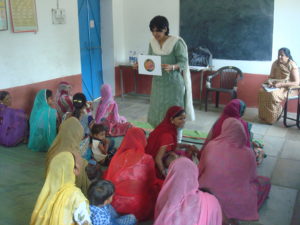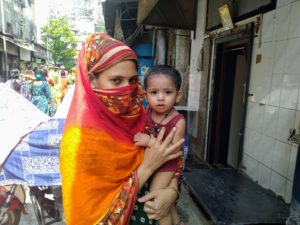Covid-19 pushes malnutrition targets further away from India

Though India has been trying to tackle malnutrition for decades the number of stunted children remains highest in the world (MIG Photos/Aman Kanojiya)
Disruption of food supply chain as well as the economic burden imposed by Covid-19 pandemic may have led to a sharp rise in the incidents of malnutrition around the world and especially in India which even before the pandemic had consistently recorded the largest number of malnutrition cases and stunted children in the world. A recent report in Lancet magazine said that the pandemic may lead to increase by a sixth in stunting or wasting of children below five years of age in 118 low-and-middle income countries across the globe. That translates into seven million more stunted children, to add to the pre-pandemic estimate of 47 million stunted children. Lancet also said that over 100,000 children may have already died this year due to malnutrition.
Experts believe that even though data is not yet available, Covid-19 may have already taken its toll due to several reasons – notably disruption of food supplies as well as millions of precariously poised people who lost their jobs. “We are yet to see its impact, but it’s going to be really bad. People working on daily wages lost their jobs during lockdown. So did farmers. The first place where human being will compromise is food. Even though the government provided them with food rations, but when I went and interviewed people, they said it’s not enough as we have bigger families. Covid-19 is going to increase malnutrition in India by two-fold. I want to see what next survey tells us about stunted growth and malnutrition,” Prachi Pandit, a nutrition expert from Pune, makes a dire prediction while talking to Media India Group.
She goes on to say that girls and women may be much more impacted by the rise in malnutrition during the pandemic than the males. This gender bias is deeply ingrained in the Indian mindset and is very difficult to change, says Pandit, co-founder and director of Arbuza Regenerate, a company focused on addressing issues in population health.
Gender bias
As with several other aspects in terms of education or financial independence, the problem of malnutrition too has a strong bias against woman and girl child. For instance, child mortality in India is higher for females than that for males. While the under-five mortality rates for males is 38.4, for females it stands at 40.4. This shows that girls have a higher probability of dying before attaining the age of five years than boys.
Research shows that girls are neglected since the time of birth and are not given food properly as they are considered to be a burden in most Indian households. Boys on the other hand are fed properly. The gap between feeding a girl and a boy child becomes sharper in adolescence, experts say.
“If we see the dietary plans of a girl in rural India, we will see that large amount of the diet lacks protein and nutrition especially micronutrients, and the diets mostly nowadays consist of carbohydrates and junk food and junk food has reached the rural part of India. Why I am talking about a girl and not a boy is because a boy is always fed more. Gender bias is always there. The girl is eating less in terms of both quality and quantity. So, girls have borderline anemia when they hit puberty and get periods. When she gets married and then pregnant, she already is anemic. Then she is carrying a child with a low quantity quality of food and obviously the intra-uterine problem starts from there and then there is the whole cycle that keeps repeating itself for generations,” Pandit says.
The girl child experiences mistreatment and neglect from the time of birth and thereafter. Noted economist Jean Drèze and Nobel laureate Amartya Sen have also documented that girls are breast-fed for a shorter period of time than boys. Moreover, right from her early childhood, the girl child faces a disadvantage in accessing nutrition, significantly increasing the risk of morbidity and mortality. Based on her analysis of differential treatment of girls and boys in North India, American nutritionist Barbara Miller terms the prevailing anti-female bias as ‘extended infanticide.’ This may be the primary reason why the cases of low birth weight children in India is the highest worldwide.
Pandit, who has worked extensively in villages as well as urban areas in different parts of the country, says that even though for most government programmes launched to address the issue of malnutrition, the communication was often ineffective or futile because those formulating the programmes and the communication may have had little exposure to the real life situations on the ground.
Challenge of behavioural change
Pandit says that while India has done very well in collecting data and reaching out to the last mile in terms of various organisations working in this domain, but not much change has been brought about as yet. She adds that the real problem in ending malnutrition is not making the mother or girl child aware about the importance of a balanced and nutritious diet, but in bringing about a behavioural change.
“We need right people in the field. I think we need to focus on behaviourial change communication in nutrition than just launching programmes. Because if programmes had to do anything we would have done it long time back. We have launched so many of them. If you pick up last 10 years you will see in all the age groups, we have launched programmes. Yet we have not been able to achieve what we targeted,” adds Pandit.
Chief of Nutrition at UNICEF India Arjan de Wagt also believes that while India has the necessary programmes design and even the support staff, its implementation needs improvement.
“In India the policies and guidelines are brilliant. There are very few countries that have got such great policies, programmes and schemes. Let’s take Integrated Child Development Services (ICDS) for example, that is about 50 years old. You have Anganwadi workers, Community workers providing food, counselling and support. If I had to design them as a technician, I wouldn’t do much better than what they have. It’s not really about the design but about the implementation,” de Wagt tells Media India Group.

Prachi Pandit informing women about the importance of proper nutrition for mother and child (Photo: Prachi Pandit)
“While doing my survey in Rajasthan, I found that probably most of the women knew more than me on what they should eat but they are not doing it. It doesn’t happen in action. And if you go deeper as in why it doesn’t happen in action is because I am talking to a powerless person who does not have enough money to buy green vegetables. She listens to me because that’s what she is supposed to do when she comes in a primary healthcare centre. But once back home, she goes back to the same old behaviour. So, if I want to change the existing situation, I need to dig deeper into behaviour and probably hold other people accountable in her life who have more power to influence her behaviour,” Pandit tells Media India Group.
Involving decision makers in family – husbands and mothers-in-law
Pandit goes on to say that not just the pregnant or lactating women, people in the house that need to be made aware of the risks of malnutrition are the husbands and mothers-in-law who wield a great deal of power in decision making in the household. It is the men who need to be convinced and encouraged when it comes to providing proper nutrition to their wives during pregnancy.
“When I went to a couple of pregnant women and asked them if they had considered eating an iron tablet, because for the last 25 years the government is giving free IFA (iron folic acid) tablets to all the lower economy class as the consumption of IFA tablets is not high. So, if you go to them and ask them why they are not having, they would come up with excuses that the iron consumption tablets would make my kid darker in colour or since this is free, I am not sure about the quality of it. Third they say they get upset stomach because of the consumption of iron folic acid tablets and fourth can be that my family doesn’t allow me to do that,” she says.
“We saw that talking to them alone would not solve the problem, so we involved the men in the family. We realised that the men or the mother in law influence the 18 or 19-year-old pregnant women. Changing their behaviour or educating them to help the pregnant woman consume the iron folic acid would work better,” she says.
In a traditional Indian household, rural or urban, men have kept away from pregnancy and lactation considering it is a womanly thing and they cannot interfere in kitchen and other such matters. Pandit says that she and her team approached the men with a message that it was cool to take care of one’s wife and no one was less manly if they took her to hospital or bought fruits for her. “We made a movie that was telecast on television channels and radio as well. Simultaneously, we also approached mothers-in-law of pregnant women with the message that they ought to take care of the nutrition of the woman in order to ensure the birth of a healthy child. Mother-in-law in any household has tremendous influence and we could see the impact of our messaging fairly rapidly,” Pandit says.

Malnutrition is not a problem just in rural India but also in urban areas (MIG photos/ Varsha Singh)
India on track to miss UNSDGs
Despite having addressed the challenge of malnutrition for several decades, India is on track to miss all the targets for eliminating malnutrition by 2030 as per the United Nations Sustainable Development Goals. Pandit says the country needs a significant course correction in order to catch up with other nations and for it to eliminate the malaise from the society.
“We need recommendations targeting various aspects of malnutrition — culturally, ethically and socio-economic status wise. We cannot have generalised recommendations, or ask everyone to have green leafy vegetables in India because people in the desert don’t grow it. these have to be tailored to the socio-economic status and the ethnicity of your culture, what group of beneficiaries are you talking to. Also, we need to train the healthcare workers or ASHA and Angandwadi workers, who are the primary point of contact with the target group people,” she says.
Though the extent of real impact of Covid-19 pandemic on malnutrition will not be known for at least another year, but it is certain to have worsened the situation for millions of poor, both in villages and urban areas. This is certain to have erased India’s past achievements in tackling malnutrition to a certain level. Whenever the programmes do get back on track, however, the government must not forget roping in the men and elder women in households to make a real dent in eradicating the malaise.









